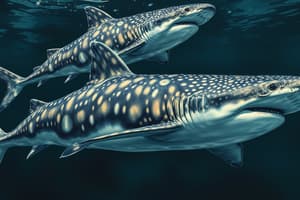Podcast
Questions and Answers
What material primarily composes baleen plates in baleen whales?
What material primarily composes baleen plates in baleen whales?
- Collagen, a fibrous protein found in connective tissues
- Chitin, a polysaccharide found in crustacean shells
- Calcium phosphate, the main mineral component of bones
- Keratin, a structural protein also found in fingernails (correct)
Which hunting technique involves a group of whales creating a 'net' of bubbles to trap fish?
Which hunting technique involves a group of whales creating a 'net' of bubbles to trap fish?
- Filter feeding
- Bubble netting (correct)
- Ram feeding
- Echolocation hunting
What is the primary function of baleen in baleen whales?
What is the primary function of baleen in baleen whales?
- To create hydrodynamic propulsion in water
- To attract mates through complex sound vibrations
- To filter small organisms from water for consumption (correct)
- To crush and chew large prey items
Which of the following marine animals is LEAST likely to be part of a typical baleen whale's diet?
Which of the following marine animals is LEAST likely to be part of a typical baleen whale's diet?
Killer whales are classified as what type of whale based on their mouth structure?
Killer whales are classified as what type of whale based on their mouth structure?
What is the term for the group hunting behavior exhibited by killer whales when targeting large prey?
What is the term for the group hunting behavior exhibited by killer whales when targeting large prey?
Which feeding strategy do toothed whales use to locate prey by emitting sounds and interpreting returning signals?
Which feeding strategy do toothed whales use to locate prey by emitting sounds and interpreting returning signals?
Which of the following is a primary component of the diet for most toothed whales, excluding killer whales?
Which of the following is a primary component of the diet for most toothed whales, excluding killer whales?
Which of the following best describes how baleen whales consume their food?
Which of the following best describes how baleen whales consume their food?
Crabs, shrimp, and krill share which common classification that makes them a food source for some whales?
Crabs, shrimp, and krill share which common classification that makes them a food source for some whales?
Flashcards
Whale Classification by Feeding
Whale Classification by Feeding
Whales can be categorized based on their feeding method: toothed whales possess teeth, while baleen whales have baleen plates instead.
Toothed Whales
Toothed Whales
Toothed whales, like killer whales and dolphins, have teeth for capturing and consuming prey.
Baleen Whales
Baleen Whales
Baleen whales, such as humpback whales, possess baleen plates instead of teeth. Baleen is made of keratin, similar to human fingernails, and acts as a filtering system for catching small food.
Whale Diet: Location & Food Chain
Whale Diet: Location & Food Chain
Signup and view all the flashcards
Humpback Whale Bubble Netting
Humpback Whale Bubble Netting
Signup and view all the flashcards
Echolocation
Echolocation
Signup and view all the flashcards
Killer Whale Diet
Killer Whale Diet
Signup and view all the flashcards
Toothed Whale Diet (Excluding Killer Whales)
Toothed Whale Diet (Excluding Killer Whales)
Signup and view all the flashcards
Baleen Whale Diet
Baleen Whale Diet
Signup and view all the flashcards
Baleen Whale Feeding Technique
Baleen Whale Feeding Technique
Signup and view all the flashcards
Study Notes
Whale Classification and Diet
- Whales are classified as toothed or baleen.
- Toothed whales have teeth and include killer whales, dolphins, porpoises, belugas, narwhals, beaked whales.
- Baleen whales have baleen instead of teeth; examples include humpback whales, right whales, gray whales, rorquals.
- Baleen is keratin material forming plates that hang from the whales' upper jaws.
- Spaces between plates filter water and catch food.
- Food varies depending on the whale's location and position in the food chain.
Toothed Whale Diet
- Killer whales (Orcas) are apex predators.
- They eat sea lions, walruses, dolphins, porpoises, seals, sharks, seabirds, and penguins.
- They often hunt in groups (pods) for larger prey, a process sometimes taking several hours.
- Other toothed whales (dolphins, porpoises, belugas, narwhals, beaked whales) mostly eat octopuses, squid, fish, and crustaceans.
Baleen Whale Diet
- Baleen whales open their mouths wide to filter water and swallow trapped food.
- Baleen whales eat small crabs, octopuses, zooplankton, fish, krill, and certain crustaceans.
- Whales can hunt alone or in groups.
- Different baleen whale species have diverse diets.
- Gray whales feed on ocean bottom organisms (marine worms, invertebrates).
- Right whales eat krill, small crustaceans, and zooplankton.
- Fin whales eat schooling fish, crustaceans, and squids.
- Blue whales mainly eat krill.
- Humpback whales consume mackerel, krill, schooling fish, anchovies, and sardines.
Whale Feeding Strategies
- Humpback whales use bubble nets to trap fish.
- Bubbles form a net-like structure, trapping fish that whales gulp down.
- Some whales use echolocation to locate prey.
- Whales send out sounds and interpret the returning signals to determine prey's location, size and type.
Studying That Suits You
Use AI to generate personalized quizzes and flashcards to suit your learning preferences.




